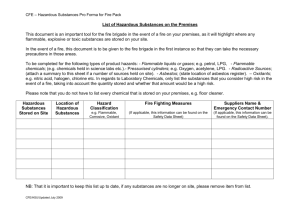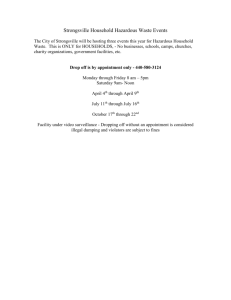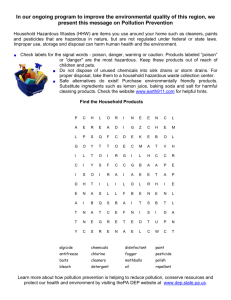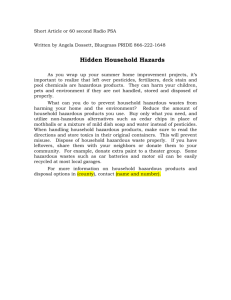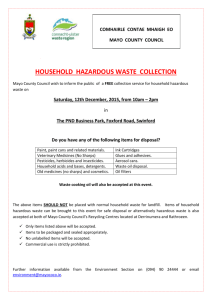Hazards of Common Household Chemicals Grades
advertisement
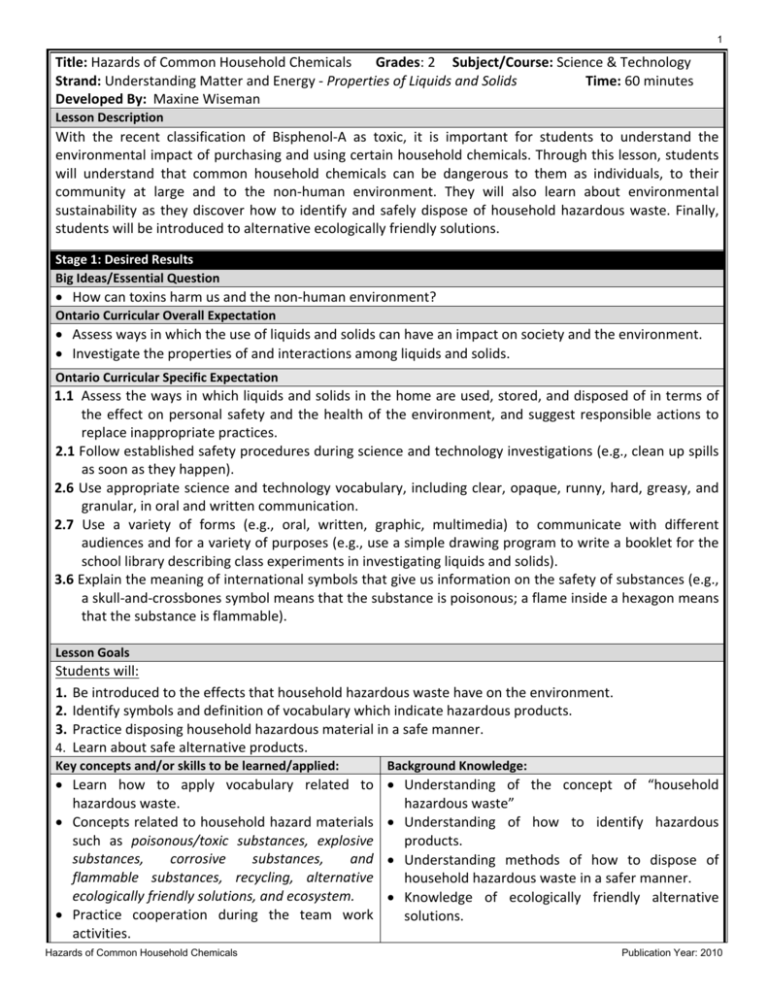
1 Title: Hazards of Common Household Chemicals Grades: 2 Subject/Course: Science & Technology Strand: Understanding Matter and Energy - Properties of Liquids and Solids Time: 60 minutes Developed By: Maxine Wiseman Lesson Description With the recent classification of Bisphenol-A as toxic, it is important for students to understand the environmental impact of purchasing and using certain household chemicals. Through this lesson, students will understand that common household chemicals can be dangerous to them as individuals, to their community at large and to the non-human environment. They will also learn about environmental sustainability as they discover how to identify and safely dispose of household hazardous waste. Finally, students will be introduced to alternative ecologically friendly solutions. Stage 1: Desired Results Big Ideas/Essential Question • How can toxins harm us and the non-human environment? Ontario Curricular Overall Expectation • Assess ways in which the use of liquids and solids can have an impact on society and the environment. • Investigate the properties of and interactions among liquids and solids. Ontario Curricular Specific Expectation 1.1 Assess the ways in which liquids and solids in the home are used, stored, and disposed of in terms of the effect on personal safety and the health of the environment, and suggest responsible actions to replace inappropriate practices. 2.1 Follow established safety procedures during science and technology investigations (e.g., clean up spills as soon as they happen). 2.6 Use appropriate science and technology vocabulary, including clear, opaque, runny, hard, greasy, and granular, in oral and written communication. 2.7 Use a variety of forms (e.g., oral, written, graphic, multimedia) to communicate with different audiences and for a variety of purposes (e.g., use a simple drawing program to write a booklet for the school library describing class experiments in investigating liquids and solids). 3.6 Explain the meaning of international symbols that give us information on the safety of substances (e.g., a skull-and-crossbones symbol means that the substance is poisonous; a flame inside a hexagon means that the substance is flammable). Lesson Goals Students will: 1. Be introduced to the effects that household hazardous waste have on the environment. 2. Identify symbols and definition of vocabulary which indicate hazardous products. 3. Practice disposing household hazardous material in a safe manner. 4. Learn about safe alternative products. Key concepts and/or skills to be learned/applied: Background Knowledge: • Learn how to apply vocabulary related to hazardous waste. • Concepts related to household hazard materials such as poisonous/toxic substances, explosive substances, corrosive substances, and flammable substances, recycling, alternative ecologically friendly solutions, and ecosystem. • Practice cooperation during the team work activities. • Understanding of the concept of “household hazardous waste” • Understanding of how to identify hazardous products. • Understanding methods of how to dispose of household hazardous waste in a safer manner. • Knowledge of ecologically friendly alternative solutions. Hazards of Common Household Chemicals Publication Year: 2010 2 • Problem solving to determine what products are hazardous, and decision making on how to dispose of them. • They will critically reflect about hazardous household materials. Stage 2: Planning learning experience and instruction Student Groupings Instructional Strategies • Whole group • Small groups of 4 students • • • • Materials Considerations • Notebooks , pencils, pens • Newspaper, • Soap ,water, borax, eucalyptus oil and a spray bottle • Safety goggles, smocks and latex gloves • Smart board or video projector, and laptop • For extension activities, you may need: Markers, flyers, magazines • tape or glue, scissors and poster material Time of year: If this lesson is taught during the fall or spring, the disposal prochain of the lesson can be done outdoors. This may give the students a greater sense of appreciation for nature and the environment. Some students may be allergic to certain household products. If so, these students should not have contact with these products. As an alternative activity, they can participate in the interactive online activity. http://toxmystery.nlm.nih.gov Teacher lead discussion Cooperative learning Small group assignment/discussion Whole group discussion Accommodations • Students may dictate their response using a digital voice recorder instead of writing in the worksheet. • Students who are not comfortable to share their ideas during larger group discussions may share these ideas with the teacher during one on one conferencing. Stage 3: Learning experience and instruction Motivational Hook ( 5 MINS.): • Handout stickers of 4 different hazardous symbols and ask the students to place it on their shirts for everyone to see. • Ask the students to organize themselves into groups based on the appearance of their symbols. Open ( 10 MINS): • Initiate the teacher lead discussion by asking the students to describe their group’s symbol, and find out what they think the symbols represent. Body (40 MINS): • Continue the opening discussion by creating a concept map on the board around hazardous waste. While doing this, explain the meaning of household hazardous waste, and the potential dangers of such products. Household hazardous waste is the discarded, unused, or leftover portion of household products containing toxic chemicals. These wastes CANNOT be disposed of in regular garbage. • Explain how they affect us as individuals, within the community, and within the non-human environment e.g. “Commonly used hazardous products can pollute the air, water, and soil, and recombine to form other even more dangerous compounds. Persistent substances can build up in the bodies of wildlife. They can also accumulate in the fruits and vegetables we grow and in the livestock we raise. Trace amounts can contaminate groundwater supplies and well water.” http://www.earthday.ca/pub/assets/pdfs/CAN/back_household.pdf (Approx. 5 min). Hazards of Common Household Chemicals Publication Year: 2010 3 • Have the students remain in their groups as you share with them the meaning behind their symbols. Incorporate these into the concept map. Provide a detailed definition for poisonous/toxic substances: are dangerous to people and animals even in small amounts. Capable of causing injury or death, especially by chemical means e.g. bleach. Explosive substances: produce vapour or explode when they react with other substances e.g. fireworks. Corrosive substances: it eats away at other substances and even kills skin tissue e.g. car batteries. Flammable substances: are gases, liquids and solids that will ignite and continue to burn in air if exposed to a source of ignition e.g. gasoline lighter. Review the definitions with the class and explain any vocabulary that is novel to them to aid their comprehension (Approx. 10 min). • Explain how to safely dispose of these chemicals. Use a short video clip to introduce this topic from the government of Ontario’s waste recycling/disposal program “Make the Drop” (Approx. 5 min). http://www.youtube.com/watch?v=sPvg8WJDGW0 • As a follow-up to the video, provide samples of potential household hazardous products like paint cans and aerosol spray cans in the classroom. Also provide a blue recycling box, and a cardboard box labelled “Orange Drop” which ties into the hazardous waste disposal program in Ontario called “Make the Drop”. • Tell the students that we are going to pretend that we are on a game show called “Who Wants to Save the Planet?” The teacher’s role is the host of the show. The groups will choose team representatives who will act as contestants. Each contestant will be dressed in safety gear wearing safety goggles, smocks and latex gloves. They will sort through the waste and find the products which have the same symbols that match their team’s symbol (the sticker on their shirt). They must answer the following questions: A) “What is this product used for?” B) “What substance does this symbol represent?” e.g. poisonous/toxic substances, explosive substances, corrosive substances, and flammable substances. C) “How can this product be disposed of in a safe manner?” D) “Should we dispose of it in the blue recycling bin or in the orange drop bin?” The contestant can get advice from their team members. They must write the answers to the above mentioned questions on the board. Another team member will simultaneously draw a picture of this product next to the written answers. The first group to complete the answers correctly wins a prise! (Approx. 15 min). • Introduce the concept of ecologically friendly household solutions. With the assistance of a few volunteers in the class, demonstrate how to make an ecologically friendly disinfectant. Have the volunteers dress in safety gear (latex gloves, safety goggles and smocks). Explain why the solution we will make is a safer alternative than some of the store bought disinfectants. Ask the students prompting observation questions that will encourage discussion about the appearance of the ingredients before and after they are mixed e.g. are they liquids, or solids? Is the color transparent or opaque? Does it appear hard, runny, greasy or granular? What happens when they are mixed together? How does it appear? What does it smell like? Have the entire class participate by cleaning their desks with this solution (Approx. 12 min). • As an extension activity, if time permits, you could have each student mix the ingredients themselves and record their observations in their notebooks, along with a drawing of their observations. Disinfectant Ingredients and Instructions: • Wash items with soap and water or add 100 ml borax with 1 L water. • Mix 50-100 ml eucalyptus oil with 1 L of water in spray bottle; shake mixture before use to disperse the oil. Hazards of Common Household Chemicals Publication Year: 2010 4 Close (5 MINS): • Everyone will gather at the carpet and will sit down. • Ask them to express their thoughts about what was learned. This will help in assessing their comprehension of the lesson. • Provide a quick summary of what was covered in today’s lesson. • Review the homework assignment with the class: Students will fill out a worksheet that tests their knowledge about concepts and vocabulary that was taught in class. Link to Future Lessons • Using recycled materials including flyers, magazines and newspapers. The students will continue to work with their assigned group to create a collage depicting their understanding hazardous waste and its effects on society and the non-human environment. They may include the appropriate warning symbols next to each product and label them accordingly. Students will have the opportunity to share their collage and the meaning behind it to grade one students. This assignment could later expand in their Language Arts class where they will share what they learned in a newsletter. Copies of the newsletter can be printed and made available in the school’s library for all students to read. • The students can write a reflection in their journals about hazardous products found in their home. They can include ideas of how they can involve their family in a disposing of these hazardous wastes. Parents can sign next to the journal entry. By doing so, the students will feel that they are teaching their families to be more ecologically friendly. The journal entry will also be useful in advertizing to the student’s parents what is being taught in the class room. Assessment • I will use scaffolded guided inquiry by paying attention to science notebooks and classroom discussion to see if there are any misconceptions in the student’s understanding of the concepts learned in class. • By reviewing the student’s written homework, I will be able to gage how well students are able to communicate their knowledge and understanding, thinking, and application with regards to the concepts learned in class related to household hazard materials such as poisonous/toxic substances, explosive substances, corrosive substances, and flammable substances, recycling, alternative ecologically friendly solutions, and ecosystem. Hazards of Common Household Chemicals Publication Year: 2010 5 References BOOKS Ottawa-Carleton District School Board (2008). Educators’ Resource Guide: Assessment, Evaluation and Reporting of Student Achievement. Ottawa, Ontario: Ottawa-Carleton District School Board. (Chapters 1 and 2). Guillaume, A.M. (2008). Planning in K-12 Classroom Teaching: A Primer for New Professionals. (pp.102-107) Columbus, OH: Pearson. Mclean, L. &, Cook, S. & Crowe, T. (2006). Educating The Next Generation Of Global Citizens Through Teacher Education. Canadian Social Studies, 40 (1), pp. 1-8. Ministry of Education (2007). The Ontario Curriculum: Science and Technology, Grades 1 to 8. Parkay, F., Stanford, B., Vaillancourt, J. & Stephens, H. (2007) "Developing and Implementing the Curriculum" (pages 265-292) Becoming A Teacher. Toronto, ON: Pearson Allyn & Bacon. Selby, D. & Pike, G. (2000). The Civil Global Education. Convergence, 33 (1), pp. 138-149. Wiggins, G. & McTighe, J. (2005). Understanding by design: What is backward design? VIDEOS “Make the Drop” http://www.youtube.com/watch?v=sPvg8WJDGW0 WEBSITES http://digitalliteracy.mwg.org/curriculum/process.html http://toxmystery.nlm.nih.gov http://www.ottawa.ca/residents/recycling_garbage/hhw/index_en.html http://69.164.216.210/VirtualHouse/virtualhouse.html http://www.dowhatyoucan.ca/ http://www.makethedrop.ca/ http://www.videojug.com/interview/dangerous-consumer-products http://www.earthday.ca/pub/assets/pdfs/CAN/back_household.pdf Hazards of Common Household Chemicals Publication Year: 2010 6 Sample of stickers to be used during the opening: Homework Assignment: 1) Match the symbol with its name. Choose the symbol name from the list below: a) Flammable substance c) Corrosive substance 4) What does it means to be b) Explosive Substance d) Poisonous/toxic substance ecologically friendly? 1 2 3 4 ________________________________ ________________________________ ________________________________ ________________________________ _ _ _ _ ________________________________ _ _ _ _ ________________________________ 2) Match each with its_definition. _ hazardous substance _ _ ________________________________ Fill in the blanks below. ________________________________ Substances: ________________________________ 1. Flammable substance 2. Corrosive substance 3. Explosive Substance 4. Poisonous/toxic substance ______ ______ ______ ______ 5) On the back of this paper, using crayons or pencil crayons, draw a picture of a hazardous substance found in your home. Definitions: a. Are dangerous to humans or animals, even in small concentrations. b. Explode or produce vapours when they react with other substances. c. Eat away at other substances d. Easily sets fires 3) What does hazardous waste mean? _____________________________________________________________ _____________________________________________________________ _____________________________________________________________ _____________________________________________________________ _____________________________________________________________ ____________________________________________________________ Hazards of Common Household Chemicals b) What hazardous symbol does this product have? ________________________________ ________________________________ c) What it is the product used for? ________________________________ ________________________________ ________________________________ ________________________________ ________________________________ Publication Year: 2010


